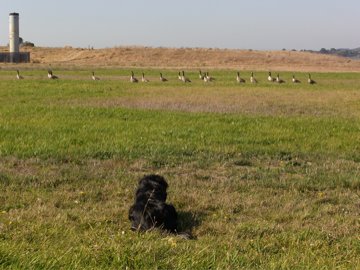
Like just about everywhere else in urban North America, the Bay Area has attracted flocks of Canada geese that like to hang out here rather than fly away home to the north and have a movie made about them. That’s their prerogative. After reading a blog post about resident Canada geese in Louisiana, and after years of seeing them more and more frequently in and around Chicago and hearing about them becoming nuisances elsewhere, I looked online for some current information. My findings, briefly:
–There are at least eight subspecies of Canada geese (Branta canadensis), including the Giant Canada Goose (B.c. maxima), which appears to be a common city dweller, and the Aleutian Canada Goose (B.c. leucopareia).
–The Aleutian Canada Goose was listed as a threatened species for three decades or so but has made a big comeback, was delisted, and is now eating ranchers and dairy farmers out of house range and home pasture on the Northern California coast.
–Canada geese, including the Aleutian variety, are still protected by the federal Migratory Bird Treaty Act. In short, that means you have to go to the U.S. Fish and Wildlife Service and/or state officials before you hunt a Canada Goose or do anything detrimental to its lifestyle.
–Canada geese are highly adaptable creatures and highly tolerant of crowded urban situations.
–They love grass and pasture. Grass that’s been fertilized: Mmmm, good. They’re partial to golf courses and parks because those locales typically have lots of well-tended grass and the other staple they require, water. They prefer areas where there are clear sight lines between grass and water because they can move back and forth without predators surprising them.
–There are still plenty of Canada honkers–the term I remember from “One Flew Over the Cuckoos Nest” for migrating Canada geese. But more and more populations of Canada geese in North America and Europe are members of “resident” flocks; they no longer travel back and forth between southern breeding grounds and summering sites in the north. The local geese still do the “V” thing when they fly, though.
–Why the shift from migratory to resident flocks? Food is plentiful in areas where flocks have settled (in many cases, people go out and feed them). They’re not hunted in these areas, and they have no natural predators beyond the occasional unleashed dog.
–Geese are really hard on pasture, and like most of us higher beings, they’re prolific excretory organisms. The combination often makes them unwelcome in the midst of Man, Builder of Sewers.
And that brings us to Wednesday, out at Chavez Park in the Berkeley Marina. I took Scout out there in the mid-afternoon. We generally cross the broad meadow from the access road to the off-leash dog area; there’s no path, and generally no people right there who might take exception, so I’m in the habit of letting him run off the leash. As we topped the little ridge on the south end of the meadow, we spotted about 20 Canada geese a couple hundred yards away. Until we got to about 100 yards, neither the birds nor the dog seemed to notice the impending encounter. At that point, Scout went into stalking mode and the geese stopped their random grazing and were paying attention to him. I tried to lead Scout around the flock, which I expected to fly up at any moment. Instead, he advance 10 or 15 yards at a time until he was pretty close–maybe 50 yards away. The geese all faced in one direction as he got closer–west-northwest, directly into the wind; I figured they did that because the extra lift they’d get from the wind would make it a little easier to take off (the same thing that pilots try to do when taking off or landing). At that point, Scout decided to go for it; he bolted toward the flock, which was into the air honking and flapping in an instant. Didn’t get a picture of that, though.
Technorati Tags: berkeley

Love that picture. Would that be the classic Canadian standoff?
The geese around here are a total nuisance.
So….close, but all the cigars he could imagine?
Lydell, I know what you mean about those cigars. Time to develop a taste for goose, I reckon. Venison too.
Nice pic, Dan. About prolific excretory organisms: I had two wild turkeys hanging out at my place a few months ago. I still have excretory evidence in various places around the yard. That was just two large birds. Some of my neighbors have 40-50 of these Canada geese hanging out in their yards. I like seeing them and they make for nice pictures but I’m glad they’re in someone else’s yard. I can live with the guilt.
In New Zealand you’ll see American turkeys wandering along roads and through pastures. It is the weirdest sight, considering they are anything but native to the region. Probably brought here by some enterprising person, they are not in the least bit popular for eating. That said, I could be persuaded to go after them. Living the free-range good life, they look very healthy.